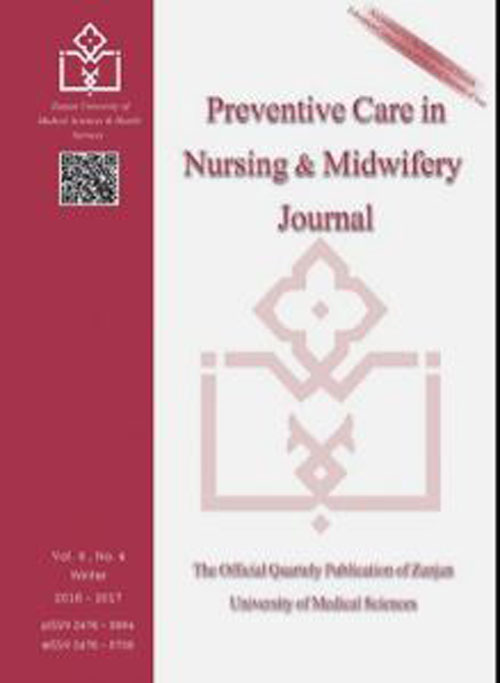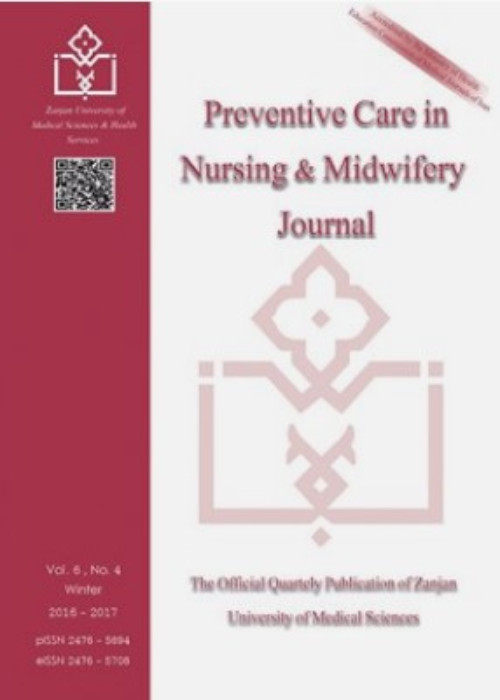فهرست مطالب

Preventive Care in Nursing & Midwifery Journal
Volume:12 Issue: 2, Summer 2022
- تاریخ انتشار: 1401/02/11
- تعداد عناوین: 8
-
-
Pages 1-9Background
Nurses are among the individuals who are under various forms of stress and physical and psychological harm due to the nature of their occupation.
ObjectivesThe present study aimed to investigate the mediating role of self-compassion in the relationship between spiritual intelligence and hope in female nurses.
MethodsThe method of the current research was descriptive-correlational. In this research, 183 female nurses of Neyshabur hospitals were selected by convenience sampling method in 2019. Participants completed King’s Spiritual Intelligence Questionnaire (2008), Snyder’s Hope Questionnaire (2000), and Neff’s Self-Compassion Scale (2003). The data were analyzed using SPSS software version 24, descriptive statistics (mean, standard deviation, frequency, and frequency percentage), path analysis method, and Pearson correlation coefficient.
ResultsThe mean (SD) age of participants was 35.22(5.91) years. Spiritual intelligence and self-compassion were predictors of hope in female nurses (p<0.005). Overall, the results showed that self-compassion had a mediating role in the relationship between spiritual intelligence and hope in female nurses (p<0.05).
ConclusionAccording to the findings, it seems that individuals who have high spiritual intelligence feel self-compassion and therefore are more hopeful.
Keywords: self-compassion, spiritual intelligence, hope, female nurses -
Pages 10-17Background
Accidents are among the most important causes of preventable death in young children, so it is of paramount importance to pay attention to safety principles in kindergartens.
ObjectivesThis study was conducted to assess the non-structural safety of kindergartens in Tehran in 2020.
MethodsThis descriptive cross-sectional study was performed in 175 kindergartens in Tehran-Iran during the autumn of 2020, which were selected by two-step cluster sampling. Data collection tools included checklists for manpower information and construction specifications, as well as a revised safety checklist designed by the Ministry of Health. Data analysis was performed by SPSS 16 software applying descriptive statistics and the Chi-square test.
ResultsThe safety of 65.1% and 34.9% of the kindergartens was very good and good, respectively. Based on the findings of this study, the non-structural safety of the kindergartens was significantly associated with neither manpower information nor construction specifications (P>0.05).
ConclusionTehran’s kindergartens were in good condition in terms of non-structural safety. As the safety status of toys was lower compared to other areas, it is suggested to pay special attention to improving the safety of toys.
Keywords: accidents, non-structural safety, kindergarten -
Pages 18-23Background
Chronic pain is a debilitating situation associated with some psychological variables.
ObjectivesThis research was conducted to evaluate the effectiveness of cognitive therapy on hope and pain management in women with chronic pain.
MethodsThe present research was a quasi-experimental study with a pretest-posttest design and a control group. The study population included women living in region one of the city of Rasht referring to Guilan Pain Clinic in 2017-2018, of which 20 people were included in the study by convenience sampling method and were divided into two experimental (10 people) and control (10 people) groups by random assignment method. Before training, both groups completed the Miller Hope Scale (1988) and the McMillan Pain Management Questionnaire (2000). The experimental group received cognitive therapy for 8 sessions of 90 minutes, but the control group did not receive any intervention. The obtained data were entered into SPSS20 software and analyzed using descriptive statistical methods and univariate analysis of covariance (ANCOVA).
Results: The mean age of participants in this study was 46.7(8.35) years. The comparison of pretest and posttest of the mean scores of hope and pain management after the intervention showed a significant increase (p=0.000). Based on univariate ANCOVA, cognitive therapy is effective on both hope and pain management variables.
ConclusionAccording to the findings, cognitive therapy seems to be used by psychologists and related experts as a low-cost method by increasing hope and improving pain management in patients with chronic pain.
Keywords: cognitive therapy, hope, pain management, chronic pain, women -
Pages 24-31Background
Caring has been introduced as the essence and central value of nursing. One of the factors influencing holistic care is organizational commitment.
ObjectivesThis study aimed to investigate the relationship between organizational commitment and perceptions of caring behavior from the perspective of nurses.
MethodsThis descriptive correlational study was performed in hospitals affiliated to Shiraz University of Medical Sciences, Fars, Iran, in 2019. The sample size was 210 nurses working in public wards who were randomly included in the study. The data were collected by two standard questionnaires, namely Allen and Meyer Organizational Commitment and Watson Perceptions of Caring Behaviors. The data were analyzed by Pearson correlation coefficient, independent t-test, by SPSS 25.
ResultsThe results showed that the mean (SD) value of organizational commitment of the nurses in this study was 95.30(16.54) at a high level. Additionally, the mean (SD) score of perceiving caring behavior was 142.49(10.71) at a relatively desirable level. There was also a direct and significant relationship between organizational commitment and perceptions of caring behavior (P=0.03; r=0.149).
ConclusionThe results of this study indicate a positive relationship between organizational commitment and perceptions of caring behavior. The findings of the present study can help nursing managers and policymakers provide the infrastructure of proper human resource management in the health system and plan to improve the dimensions of organizational commitment and perceptions of nursing caring behavior.
Keywords: organizational commitment, caring, nurses, behavior, watson’s theoryory -
Pages 32-38Background
The physical-mental health status of health care providers and patients can be influenced by the leadership styles of head nurses and health centers managers.
ObjectivesThe current study aimed to study the leadership styles of head nurses working in the training hospitals of Zanjan in 2020.
MethodsIn the current descriptive study 346 nurses working in the training hospitals wards affiliated to Zanjan University of Medical Sciences participated through cluster random sampling. A tool including demographic and Multifactor Leadership Questionnaire was used to collect data. Data were analyzed using descriptive- inferential tests such as mean, standard deviation and analysis variance and LSD by SPSS software version 25.
ResultsHead nurses adopted transformational (3.02+0.61), laissez-fair (2.94+0.92) and transactional (2.81+0.53) leadership styles, respectively. The relationship between the leadership styles and the type of hospitals and the wards was significant (p<0.05). Bu Ali Sina Hospital had the highest percentage of using transformational and laissez-fair leadership styles and Ayat –Allah Mousavi Hospital had the highest percentage of using transactional leadership style as well. Concerning the wards, pediatric and neonatal wards used the most of the transformational leadership style and the highest percentage of using transactional and laissez-fair leadership styles was associated with psychiatric ward.
ConclusionDue to the superiority of transactional leadership style over the laissez-fair leadership style, it can be said that head nurses give less freedom to the nurses working in their wards. Therefore, motivating head nurses to be innovative and further use of laissez –fair leadership style is recommended.
Keywords: leadership style, nurses, Zanjan -
Pages 39-49Background
Surgery is a stressful event that can be accompanied by a great deal of fear and anxiety, especially in emergency situations.
ObjectivesThis study aimed to determine the level of fear of hospitalization and associated anxiety and factors in the candidates of emergency surgery referring to the hospitals affiliated with Zanjan University of Medical Sciences.
MethodsThis descriptive cross-sectional study was performed on 304 patients admitted to the emergency department and their family members, referring to the hospitals affiliated with Zanjan University of Medical Sciences in 2020. The patients were recruited by convenience sampling. Data collection tools included a questionnaire for demographic information and disease specifications, the hospitalization fear questionnaire (Slobodan M. Jankovic), and the Visual Analogue Scale (10-point) to assess pain and anxiety in the emergency departments. For data analysis, independent t-test, analysis of variance (followed by the LSD post hoc test), Pearson correlation, and stepwise multiple regression were used by SPSS 22.
ResultsThe results showed that a higher number of the patients (61.4%) experienced anxiety rather than hospitalization fear (23.2%). The pain had a negative correlation with patients’ and their companions’ fear of hospitalization and a positive correlation with their level of anxiety. Also, the anxiety of the patient's companion increased with the prolongation of the waiting time. The companion’s hospitalization fear and anxiety significantly correlated with the patient’s level of anxiety (P<0.05), and the patient’s anxiety was negatively associated with systolic and diastolic blood pressure and the level of consciousness. In addition, fear of hospitalization and anxiety positively and significantly correlated with the pulse rate (P<0.05).
ConclusionAccording to the results of this study, it is recommended to provide psychological support to the patient and his/her family, try to stabilize the patient’s clinical condition, and shorten the waiting time in the emergency department to be able to manage the patient’s fear of hospitalization and anxiety.
Keywords: hospitalization, fear, emergencies, surgery -
Pages 50-61Background
Fear of childbirth is one of the major problems during pregnancy and the post-partum period that affects women’s health and preference for cesarean birth.
ObjectivesThe present study aimed to investigate the effect of midwife-oriented education and counseling on the type and consequences of childbirth in first-time pregnant women with fear of childbirth.
MethodsThe present study is a single-blind randomized controlled trial performed on 122 first-time pregnant women with fear of childbirth. The samples were selected by the convenient sampling method and divided into two intervention and control groups by the four-blocked randomization method. Data collection tools were a demographic questionnaire and the Wijma Delivery Expectancy/Experience Questionnaire (WDEQ; version A before childbirth and version B after childbirth). The intervention was performed in the form of six counseling sessions based on the Gamble approach. The data were analyzed at a significance level of 0.05 using SPSS 21 statistical software.
ResultsRegarding the effect of midwife-oriented counseling on pre-partum and post-partum fear, no statistically significant difference was observed between the two groups. The rate of choosing vaginal birth in the intervention group significantly increased after receiving counseling (p = 0.001). The frequency of vaginal birth, childbirth satisfaction, and childbirth consequences was not statistically significant between the two groups.
ConclusionThe present counseling method can be effective in increasing choosing vaginal birth in first-time pregnant women with fear of childbirth, but further research is required to evaluate its effectiveness on the maternal and neonatal consequences.
Keywords: midwifery counseling, fear of childbirth, consequences of childbirth -
Pages 62-70Background
Pain management in patients with breast cancer is possible when it is considered in connection with emotional regulation. In patients with emotional problems and anxiety, emotion regulation can be good predictors for controlling their negative emotions.
ObjectivesThis study aimed to explain the pain management model based on rumination and positive and negative emotional regulation mediating vitality in women with breast cancer.
MethodsThe research method was descriptive correlation modeling (structural equations). Participants in this study were women with breast cancer referred to all medical centers (hospitals and private and public clinics) in Tehran, of whom 273 were randomly selected. To measure the research variables, rumination response questionnaires, positive and negative emotional regulation, and vitality and pain management scales were used. SPSS 22 and LISREL 8.80 software were used to perform Spearman’s correlation coefficient test and path analysis for data analysis.
ResultsThe results showed that the indirect effect of positive emotional regulation was significant on vitality-mediated catastrophe (β=-0.07, P≤0.05). Also, the indirect effect of negative emotional regulation was significant on vitality-mediated catastrophe (β=0.11, P≤0.05).
ConclusionIt can be concluded that the pain management model based on rumination and positive and negative emotional regulation with vitality mediation in women with breast cancer has sufficient fitness.
Keywords: Pain management, rumination, positive, negative emotional regulation, vitality, breast cancer, structural equation modeling


